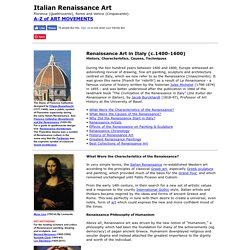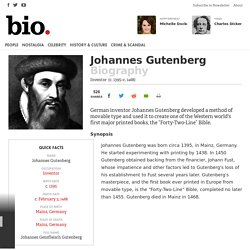

Renaissance. Renaissance Thomas J.

Kehoe, Harold E. Damerow, and Jose Marie Duvall,Exploring Western Civilization to 1648: A Worktext for the Active Student. (Dubuque, Iowa: Kendall/Hunt Publishing Co., 1997) pp. 411 - 436. “Renaissance” means “rebirth” in the French language. The Renaissance was a rebirth in a second sense. The Renaissance was a rebirth of the human spirit, a rebirth of creativity. Italian Beginnings The Italian Renaissance marks an important turning point in human history. What, then, is the Renaissance and why did it begin in Italy? The Middle Ages were a relatively static period. This medieval synthesis broke down shortly after 1300. When one age ends and another begins, there are cross currents. The Renaissance started in Italy because these crises within Christendom benefitted Italy. Renaissance writers were wrong to slander the Middle Ages as a Dark Age. Humanism, Secularism and Individualism in the Renaissance - the Renaissance. Humanism/Secularism In the Renaissance the main ideas of humanism came from the people opposing the ideas of the bible and of the Christian church.

As the period of medieval rule came to an end, people became more aware and known to social and humanist ideas. What citizens wanted was the place between god and man to disappear and humanists were the ones that were up to the job. Many humanists decided to look back at what the ancient Greeks and romans had already worked on as that usually provided a better of the world. The church was starting to lose the trust of its followers and that is when people decided to split from it. Splitting from the church was a big thing back in the renaissance as it meant you defied god. Renaissance Art: History, Characteristics. History of Renaissance Art The Renaissance, or Rinascimento, was largely fostered by the post-feudal growth of the independent city, like that found in Italy and the southern Netherlands.

Grown wealthy through commerce and industry, these cities typically had a democratic organization of guilds, though political democracy was kept at bay usually by some rich and powerful individual or family. Good examples include 15th century Florence - the focus of Italian Renaissance art - and Bruges - one of the centres of Flemish painting. They were twin pillars of European trade and finance.
FC74: The invention of the printing press and its effects. Introduction At the height of the Hussite crisis in the early 1400's, when the authorities ordered 200 manuscripts of heretical writings burned, people on both sides realized quite well the significance of that act.

Two hundred handwritten manuscripts would be hard to replace. Not only would it be a time consuming job, but also trained scribes would be hard to find. After all, most of them worked for the Church, and it seemed unlikely that the Church would loan out its scribes to copy the works of heretics. Although the Hussites more than held their own against the Church, their movement remained confined mainly to the borders of their homeland of Bohemia. Like any other invention, the printing press came along and had an impact when the right conditions existed at the right time and place. For centuries the Chinese had been making rag paper, which was made from a pulp of water and discarded rags that was then pressed into sheets of paper.
Johannes Gutenberg. Johannes Gutenberg - Inventor. German inventor Johannes Gutenberg developed a method of movable type and used it to create one of the Western world's first major printed books, the “Forty-Two-Line” Bible.

Synopsis Johannes Gutenberg was born circa 1395, in Mainz, Germany. He started experimenting with printing by 1438. In 1450 Gutenberg obtained backing from the financier, Johann Fust, whose impatience and other factors led to Gutenberg's loss of his establishment to Fust several years later. Gutenberg's masterpiece, and the first book ever printed in Europe from movable type, is the “Forty-Two-Line” Bible, completed no later than 1455. Early Life Born into a modest merchant family in Mainz, Germany, circa 1395, Johannes Gutenberg’s work as an inventor and printer would have a major impact on communication and learning worldwide. Experiments in Printing Financial Trouble In 1448, Johannes Gutenberg moved back to Mainz and by 1450 was operating a print shop.
Later Life Related Videos. Khanacademy. The Reformation - Facts & Summary.